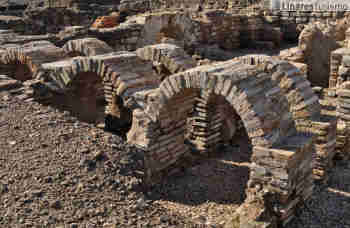Jaén – travel back to the time of the Iberians
The city and the surroundings in the province has a wealth of historical remains dated between 1 AD and 7AD
The Iberians were known for introducing agricultural instruments and weapons of iron, boosting the production of cereals and the fruit trees, the vines, almonds and olives. This for the benefit of the aristocratic society which dates from the start of the Bronze Age and has an extensive lineage.

Cástulo - Linares Turismo
These arrivals, during fourth century AD created a grand talent in sculpture workshops demonstrated by the appearances of extraordinary groupings in the localities of Porcuna and Huelma which are currently on display in the Jaén Museum.
Seven kilometres from Jaén city is Puente Tablas, a fortified city which holds a wealth of remains of great values, thanks to the large human occupation which ruled from the Bronze Age until the Islamic era, but the most important phase is the Iberian period, mainly 4C AD. Evidence of their lifestyles is seen in one of the fortress with 300 metres conserved. A city where the visitor can reach back in time to the ancient homeowners via the entrance Puerta del Sol
Close by, is the provincial museum, home to a wide selection of archaeological collections from the Iberian world, with sculptures dating from 5C AD and the Iberian monument ‘The Heroic Sanctuary of El Pajarillo’, which was located at Huelma, and dates from the 4C AD and tells of the instant when the hero was facing a wolf in the presence of two mythical beings.
In the Jaén locality of Porcuna, is another emblematic example of this society, the dynasty necropolis dated C7 AD, concretely located at Cerrillo Blanco. A funeral tomb from the Tartessica era (C7 AD) with 24 individual sculptures in one grave and one megalith where two people were buried. Until the C5 AD burials were covered sheets with large slabs of concrete, an Iberian sculptural complex destroyed intentionally. The view of the site is completed with the Porcuna Museum inside the XV Boabdil Tower.
Near the hamlet of Toya, in Peal de Becerro, a tomb which had remained hidden for 2,300 years – the best example of Iberian funeral architecture in Spain. It’s chronology in parallel with Iberian culture dates from the start of C4 AD. Here you can visit the Interpretation Centre of the Princes Tombs of Toya and Hornos, an essential visit to understand how the Iberians dealt with death and their funeral rites.
We have to turn to books to find mythological beings with only one eye belonging to a race of giants and able to build enormous constructions basically. In the Middle Age they started to build the so-called ‘cyclopaedic structures’ and it was in 1869 when Manuel de Góngora uncovered this in a book, one of the most interesting prehistoric monuments in the province, which is currently surrounded by residents and only a corner 12 x 13 metres remains conserved.
The archaeological complex and the monographic museum in Linares, are the ideal places to discover the cultural diversity of Andalucía, necropolises, factories, public infrastructures and other sub-urban installations related to the Iberia-Roman city which composes the area known as Cástulo, a space which has been conserved in exceptional circumstances, and supposes a point of great interest regarding the history of Andalucía.
The archaeological museum extends from the Cástulo, a place which hid the most important discovered relics from Léon in the Iberian-Roman era century 1BC and the Paten of Christ which dates from century 4AC.
In the municipality of Vilches, we find Giribaile, one of the Iberian largest populations in the province. Here you can visit a prehistoric sanctuary an Iberian village, a monastery, a Visigoth or Paleo Christian hermitage, and a Almohade castle, all surrounded by beautiful landscapes of olives and the sierras.
Lastly, in the locality of Castellar, a wild sanctuary from the third and fourth centuries BC. A sacred place for those who lived in the Upper Guadalquivir and where numerous dolls have been recovered. A short path of some 500 m leads to the Cave and is also ideal to regard the landscape and consider how it must have been some 2,500 years ago and the secrets which were hidden in the cave at the time.
The Route of Castles and Battle www.castillosybatallas.com
